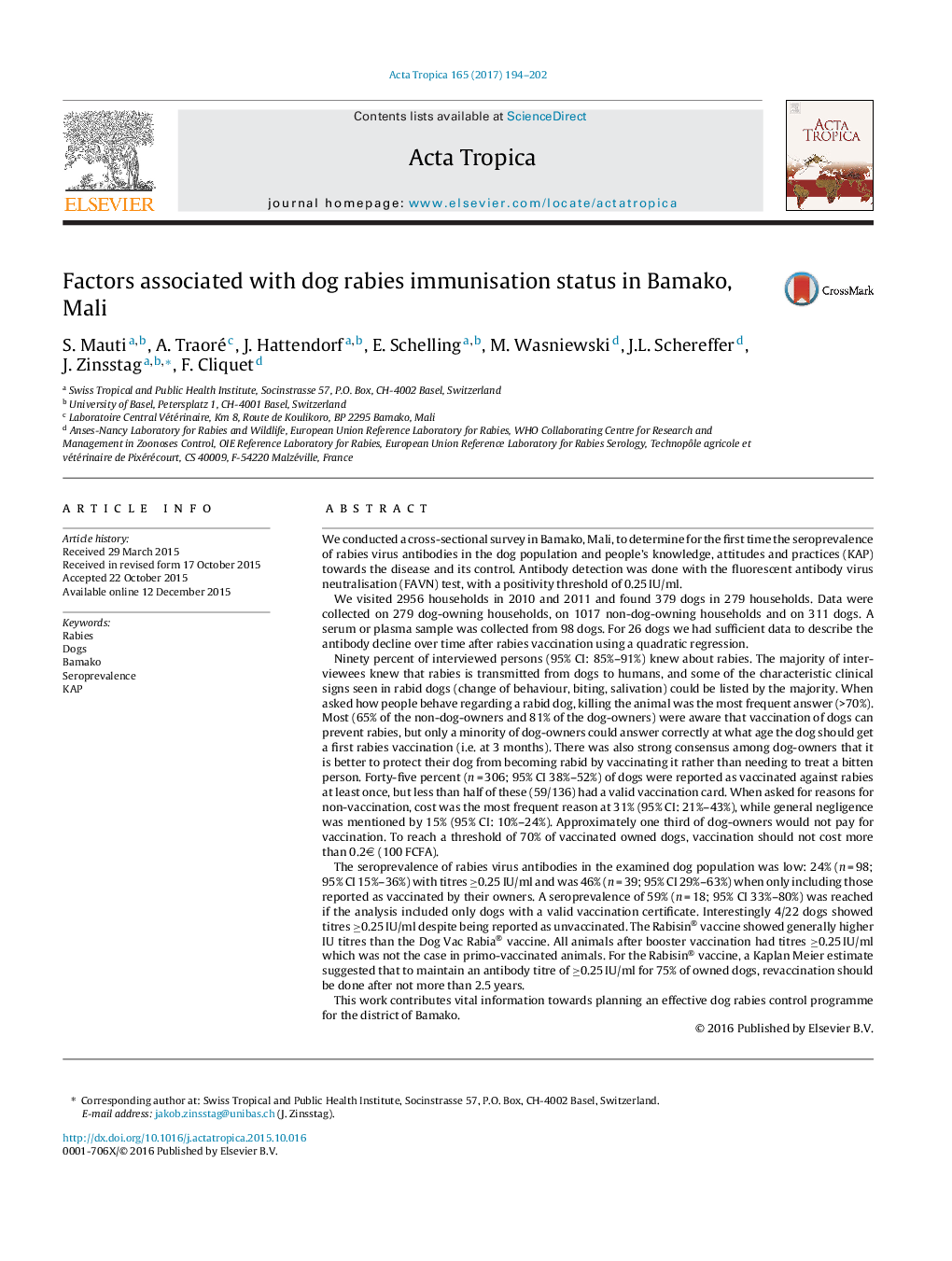| کد مقاله | کد نشریه | سال انتشار | مقاله انگلیسی | نسخه تمام متن |
|---|---|---|---|---|
| 5670836 | 1592759 | 2017 | 9 صفحه PDF | دانلود رایگان |
- First study on the seroprevalence of rabies virus antibodies in the dog population in Bamako.
- First study on the rabies virus antibody decline of dogs in Bamako.
- The seroprevalence of protective rabies virus antibodies in the dog population was too low to interrupt transmission.
- Most dog owners could not afford dog rabies vaccination.
We conducted a cross-sectional survey in Bamako, Mali, to determine for the first time the seroprevalence of rabies virus antibodies in the dog population and people's knowledge, attitudes and practices (KAP) towards the disease and its control. Antibody detection was done with the fluorescent antibody virus neutralisation (FAVN) test, with a positivity threshold of 0.25 IU/ml.We visited 2956 households in 2010 and 2011 and found 379 dogs in 279 households. Data were collected on 279 dog-owning households, on 1017 non-dog-owning households and on 311 dogs. A serum or plasma sample was collected from 98 dogs. For 26 dogs we had sufficient data to describe the antibody decline over time after rabies vaccination using a quadratic regression.Ninety percent of interviewed persons (95% CI: 85%-91%) knew about rabies. The majority of interviewees knew that rabies is transmitted from dogs to humans, and some of the characteristic clinical signs seen in rabid dogs (change of behaviour, biting, salivation) could be listed by the majority. When asked how people behave regarding a rabid dog, killing the animal was the most frequent answer (>70%). Most (65% of the non-dog-owners and 81% of the dog-owners) were aware that vaccination of dogs can prevent rabies, but only a minority of dog-owners could answer correctly at what age the dog should get a first rabies vaccination (i.e. at 3 months). There was also strong consensus among dog-owners that it is better to protect their dog from becoming rabid by vaccinating it rather than needing to treat a bitten person. Forty-five percent (n = 306; 95% CI 38%-52%) of dogs were reported as vaccinated against rabies at least once, but less than half of these (59/136) had a valid vaccination card. When asked for reasons for non-vaccination, cost was the most frequent reason at 31% (95% CI: 21%-43%), while general negligence was mentioned by 15% (95% CI: 10%-24%). Approximately one third of dog-owners would not pay for vaccination. To reach a threshold of 70% of vaccinated owned dogs, vaccination should not cost more than 0.2⬠(100 FCFA).The seroprevalence of rabies virus antibodies in the examined dog population was low: 24% (n = 98; 95% CI 15%-36%) with titres â¥0.25 IU/ml and was 46% (n = 39; 95% CI 29%-63%) when only including those reported as vaccinated by their owners. A seroprevalence of 59% (n = 18; 95% CI 33%-80%) was reached if the analysis included only dogs with a valid vaccination certificate. Interestingly 4/22 dogs showed titres â¥0.25 IU/ml despite being reported as unvaccinated. The Rabisin® vaccine showed generally higher IU titres than the Dog Vac Rabia® vaccine. All animals after booster vaccination had titres â¥0.25 IU/ml which was not the case in primo-vaccinated animals. For the Rabisin® vaccine, a Kaplan Meier estimate suggested that to maintain an antibody titre of â¥0.25 IU/ml for 75% of owned dogs, revaccination should be done after not more than 2.5 years.This work contributes vital information towards planning an effective dog rabies control programme for the district of Bamako.
53
Journal: Acta Tropica - Volume 165, January 2017, Pages 194-202
